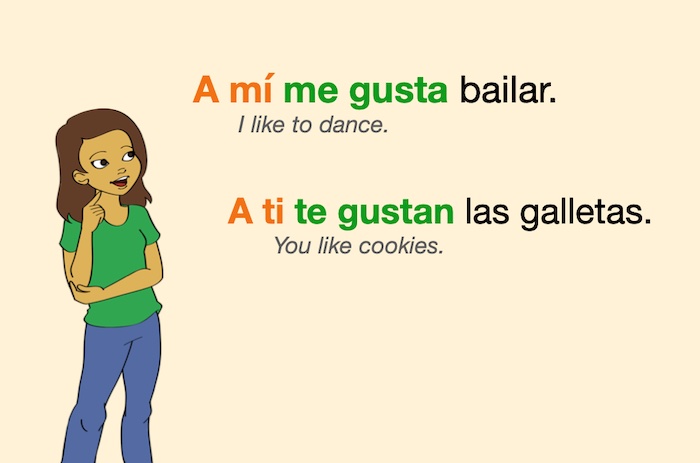Welcome 😊 to our grammar lesson on the Spanish verb gustar, which means “to be pleasing”.
We use this verb to talk about things we like (things that “are pleasing” to us).
Using “gustar” in sentences produces a particular grammar structure that the Spanish student needs to learn.

By the end of this lesson, you will be able to use “gustar” properly in sentences.
You will also find a Quiz and Exercises to practice.
“gustar” and the 2 blocks
In order to use the verb “gustar”, we need to associate each possible person with 2 blocks:
| Person | Block 1 | Block 2 |
|---|---|---|
| yo | a mí | me gusta |
| tú | a ti | te gusta |
| él ella usted María 🧑🏻 | a él a ella a usted a María a 🧑🏻 | le gusta |
| nosotros nosotras | a nosotros a nosotras | nos gusta |
| vosotros vosotras | a vosotros a vosotras | os gusta |
| ellos ellas ustedes mis amigos 🧑🏻🧑🏻 | a ellos a ellas a ustedes a mis amigos a 🧑🏻🧑🏻 | les gusta |
Notice that we have included a couple of emojis in the table? We wanted to make clear that any time we are talking about a third person (🧑🏻) or several people (🧑🏻🧑🏻) we can use the respective blocks on the right.
Here are some example sentences:
A mí me gusta Madrid. = I like Madrid. (in other words, “Madrid is pleasing to me”)
A ti te gusta la canción. = You like the song. (“The song is pleasing to you”)
A mi padre le gusta el coche. = My father likes the car.
A ella le gusta cantar. = She likes to sing.
A nosotros nos gusta la playa. = We like the beach.
A vosotros os gusta el bar. = You guys like the bar.
A ellos les gusta el jazz. = They like jazz.
A Laura y John les gusta la ensalada. = Laura and John like the salad.
Choosing between “gusta” and “gustan”
Sometimes we say “gustan” instead of “gusta” in the second block.
But when? This is the rule:
- If the thing that is pleasing is singular, we use gusta, regardless of the person.
- If the things that are pleasing are plural, we use gustan, regardless of the person.

Here are a few sentences where the things that are pleasing are plural, so we use “gustan”:
A mí me gustan las patatas fritas. = I like french fries.
A ti te gustan las bicis. = You like bikes.
A ella le gustan las manzanas. = She likes apples.
A nosotros nos gustan los libros. = We like books.
A vosotros os gustan las flores. = You guys like the flowers.
A ellos les gustan los dulces. = They like sweets.
Play with the blocks!
Once we understand the 2 blocks for each person, we actually have a lot of freedom to play around with them.
We can do all these things:
- Use just one block instead of two
- Change the order of the blocks
- Add other words such as “no” and “mucho”
Let’s study each possibility:
Using just one block
We don’t always need to use both blocks. Most times, Block 2 is enough.
For example, to say “I like ketchup”, this is enough:
Me gusta el kétchup.
We can add Block 1 if we want to emphasize the person:
A mí me gusta el kétchup.
Other times we may use only Block 1, so that we don’t keep repeating the verb “gustar” all the time:
A mí me gusta el kétchup, ¿y a ti?
I like ketchup, and you?
A mí también.
Me too.
Changing the order of the blocks
The order of the Blocks is not strict. We can change it if we want to.
The following sentences have the same meaning: “I like ketchup”:
El kétchup me gusta.
A mí el kétchup me gusta.
El kétchup me gusta a mí.
Adding words such as “no” and “mucho”
If something is not pleasing, the word “no” goes after Block 1 and before Block 2:
A mí no me gusta el tenis.
I don’t like tennis.¿No te gusta el bar?
Don’t you like the bar?A mí no.
I don’t. (meaning, I don’t like it)
The word “mucho” (“a lot, very much”), goes after Block 2:
A nosotros nos gusta mucho el baloncesto.
We like basketball a lot.Les gusta mucho la ciudad.
They like the city a lot.
“gustar” in other tenses
All sentences we have read up to this point are in Present Tense. But of course, we can also use “gustar” in past and future tenses.
The structure is the same. The only change is we must conjugate “gustar” in whatever tense we need.
For example, in Present Perfect, instead of choosing between “gusta” and “gustan”, we choose between “ha gustado” and “han gustado”:
A mí me ha gustado la película.
I have liked the movie.A mí me han gustado las películas.
I have liked the movies.
Or in Preterite Tense, we choose between “gustó” and “gustaron”:
A nosotros nos gustó el cómic.
We liked the comic.A nosotros nos gustaron los cómics.
We liked the comics.
Practice
Quiz
Take this short Quiz about the verb “gustar”:
Exercise 1: “gusta” vs “gustan”
In the following sentences, choose between “gusta” and “gustan”. Click on the gray spaces to see the solutions.
1) A mí me gustan tus pendientes.
I like your earrings.
2) A ti te gusta jugar a las cartas.
You like to play cards. (careful here: “cards” is plural, but what’s pleasing is “playing”)
3) A mi padre le gustan los coches.
My father likes cars.
4) A nosotros nos gusta la miel.
We like honey.
5) A vosotros os gusta la playa.
You guys like the beach.
6) A ellas les gustan los helados.
They like ice creams.
Exercise 2
Complete the following sentences:
1) A Pablo le gusta la película.
Pablo likes the movie.
2) A vosotras os gusta esta música.
You girls like this music.
3) A mí me gustan los barcos.
I like boats.
4) A mis padres les gusta nadar.
My parents like swimming.
5) A ti te gustan mis cómics.
You like my comics.
6) A nosotros nos gusta el mar.
We like the sea.








